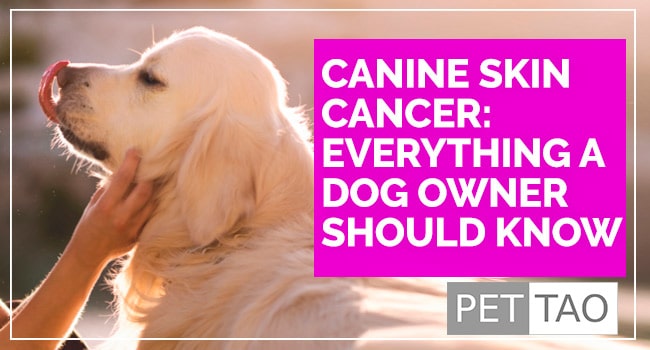Skin cancer common form of cancer in dogs.
Mast cell tumors are the most common form of dog skin cancer.
Skin cancer occurs more frequently in middle-aged to older dogs than young dogs.
Skin cancers can reside both on top of the skin or under the skin.
Benign tumors usually grow very slowly, are non-painful, and move freely.
Malignant tumors usually grow rapidly, contain ulcers, don’t heal well, and constantly ooze and bleed.
Dog skin cancer usually appears as a lump or bump, and may even look like a mole or a black spot on your pup’s skin.
Sometimes the tumor is ulcerated, sometimes not.
The skin surrounding the tumor may be red and itchy, causing your dog to scratch and lick the affected area.
You can examine your dog for skin cancer by separating the hair with your fingers and looking closely at the skin.
Skin cancer and benign tumors often look very much alike, so it is important to have any unusual growth checked by your veterinarian as soon as you find it.
You should perform a skin check at least once a month, especially if you find a growth that needs to be monitored.
Canine Skin Cancer Symptoms
The following are symptoms of skin cancer in dogs:
- Areas of color change
- Scaly or crusty lesions
- Tumors: new growths or a change in size and/or color of old growths
- Tumors that bleed easily
- Skin areas that do not heal
- Discharge from or swelling around a nipple
- Discoloration or lumps under the tail
- In the mouth, masses or tissue that differs from surrounding areas
If you find any of the situations listed above, contact your vet immediately.
Many types of skin cancer can be eradicated if caught early enough.
You can compare what you see with online photos, images and pictures, but for a final diagnosis, a trip to the vet is needed.
Sometimes dogs with skin cancer display systemic symptoms.
Systemic symptoms vary depending on the tumor’s location and how much the tumor has metastasized.
Signs of Systemic Involvement
The following symptoms:
- Loss of appetite
- Vomiting and/or bloody vomit
- Diarrhea
- Abdominal pain
- Dark or black feces
- Itchiness
- Lethargy
- Anorexia
- Irregular heart rhythm
- Irregular blood pressure
- Coughing
- Labored breathing
- Bleeding disorders
- Delayed wound healing
- Enlarged lymph nodes
For diagnosis, your veterinarian might take a sample of the growth with a needle, which is called needle aspiration.
Or, your vet may decide to completely remove the tumor and send the biopsy to a lab for analysis.
Powerful Tools for Overcoming Dog Cancer Challenges
You might not be aware, but many cancer-fighting tools are easy to get and use at home.
To realize your true cancer-fighting potential:
- Learn more about dog cancer.
- Ease your dog’s discomfort naturally. PET | TAO Comfort is a blend of Eastern herbs and Western supplements to soothe your dog’s inflammatory challenges and make him/her more comfortable.
- Boost your dog’s immune system with medicinal mushrooms. PET | TAO Complement Immune blends together the most powerful immune-boosting medicinal mushrooms on the market in a single product.
- Ease your dog’s stomach upset naturally. Many dogs with cancer suffer stomach upset as well. PET | TAO’s Harmonize GI naturally provides all the digestive enzymes and probiotics your dog needs for optimum gut health.
- Try PET | TAO Freeze Dried Beef Spleen Treats. According to TCVM, spleen helps with digestion and assimilation. Both are challenges often faced by pets suffering from cancer. As few as 5-6 treats per day can make a huge difference in your dog’s health!
- Try a Blood-building TCVM Diet. According to TCVM theory, dogs suffering from cancer also often suffer from Blood deficiency. Blood deficiency may due to chemotherapy or the cancer itself. PET | TAO Zing dog food builds Blood.
- Learn more about TCVM Herbal Remedies. Chinese medicine offers many amazing natural solutions for dog cancer challenges and palliative care. Some good examples are:








